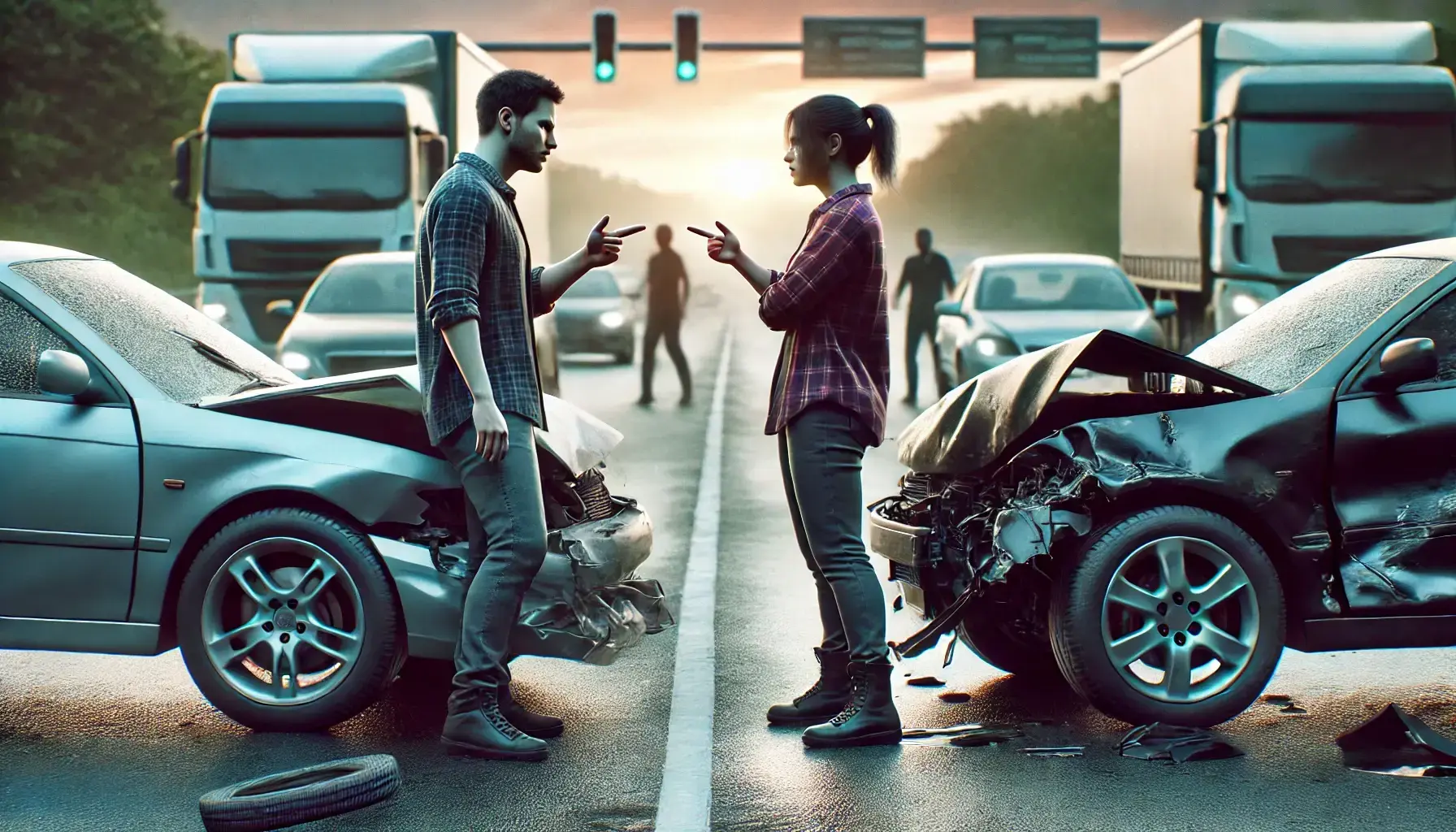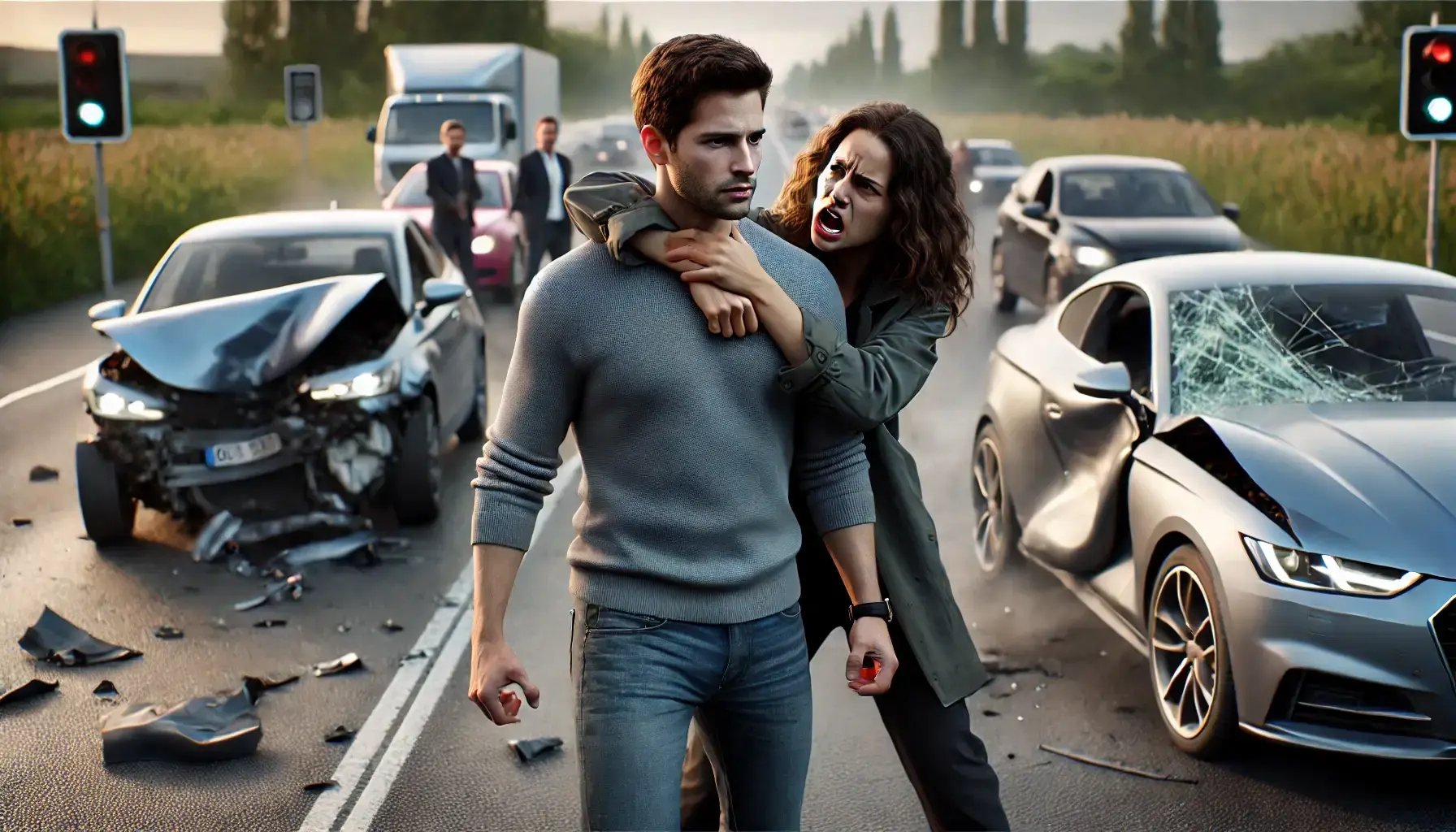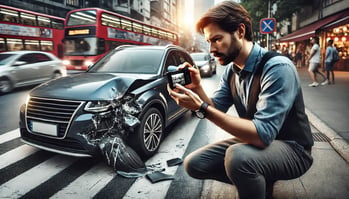Word Against Word in Car Accidents

Legally reviewed by:
Daniel Smith October 16, 2024
Determining fault after a car accident is essential, not just for insurance claims but also for any potential legal disputes. Sometimes, fault is pretty straightforward—like when someone runs a red light or loses control of their car while under the influence.
But there are times when the cause of an accident might be unclear, and it comes down to one driver’s word against the other’s, making it much harder to figure out who’s truly responsible.
When it is one person’s words versus another’s, the absence of clear evidence can make it feel like an uphill battle to prove the truth because, legally, no single driver’s account holds more weight than the other when deciding fault in these scenarios.
What Does Word-Against-Word Mean?
Word-against-word car accidents occur when both drivers narrate conflicting accounts of what happened, and there is no clear evidence to back up either side. This is common in minor collisions without witnesses, camera footage, or other objective proof to establish fault.
In these cases, it becomes challenging for insurance companies or courts to determine who is responsible. Since establishing fault is critical for settling insurance claims, insurers often dispute or deny claims when liability is unclear or doesn’t point to their policyholder.
If you are involved in a word-against-word accident, the lack of solid evidence can make it more challenging to get compensation. And the outcome will largely depend on your lawyer’s ability to gather supporting evidence and argue persuasively.
How Are Word-Against-Word Car Accident Claims Settled?
For word-against-word car accident claims, insurance companies and courts are forced to determine fault using only the available evidence and after evaluating the driver’s credibility. But they will also consider any applicable laws.
All states, for instance, have basic speed statutes that require drivers not to drive at a speed greater than is “reasonable or prudent” depending on prevalent conditions like weather, visibility, traffic, surface type, and road width. In Arizona, Ariz. Rev. Stat. § 28-701 specifies the reasonable and prudent speed in business or residential districts to be twenty-five miles per hour.
But in Pennsylvania, 75 Pa. Cons. Stat. § 3362 implements a speed limit of thirty-five miles per hour in urban districts and twenty-five miles per hour in residential districts if the highway is not a numbered traffic route and is functionally classified as a local highway.
When any of the drivers in a word-against-word accident is found to have been violating any of these fundamental traffic rules, they will be assumed to bear all the fault, even if their account suggests that the other party may also bear some blame. It is, therefore, important to know the relevant traffic rules in your state.
Lastly, factors like police reports, witness testimony, and other physical evidence may be considered when settling these claims. Insurance companies typically conduct thorough investigations and compare the statements from both drivers for inconsistencies. They may also review medical reports to see if the nature of injuries sustained corresponds with the accident described.
How Credibility is Judged

After a word-against-word car accident, the credibility of each party involved will likely impact the outcome of any subsequent claims or legal proceedings. Courts and insurance companies will examine several factors to determine which account is more reliable and establish the truth amidst conflicting testimonies. Some of the factors they will consider are:
- Consistency of Statements: One of the first things that will be evaluated in a word-against-word accident is the consistency of each driver’s statements throughout the investigation. If your story changes over time, contradicts earlier statements, or omits critical details about the crash, it can cast doubts on your credibility.
- Body Language and Demeanor: How you conduct yourself at the accident scene can influence your credibility. Drivers who remain calm, cooperate with the police, and provide clear, straightforward information may be viewed as more trustworthy.
- Driving History: A driver’s past behavior and reputation can affect their credibility. A history of traffic violations or reckless driving may cause others to question your faultlessness in the present situation. On the contrary, a clean driving record is generally viewed more favorably.
- Evidence Supporting the Story: Some evidence can strengthen or weaken your account of the accident. For example, if a driver claims they were traveling slowly but skid marks indicate otherwise, their credibility may be questioned.
- Witness Testimonies: Witness testimonies can tip credibility scales in word-against-word car accident cases. If multiple third-party witnesses corroborate a party's account, the corroboration will lend considerable weight to it and impact its credibility.
Steps To Take If You're Involved In a Word-Against-Word Car Accident
A car accident can be more overwhelming when it's your word against the other driver’s. However, knowing what steps to take can help you navigate the situation and potentially build a strong case. If you're involved in a word-against-word car accident, follow these steps to protect yourself and position yourself favorably.
Stay Calm and Document the Scene
Although it may seem difficult to stay calm, you must do so. If you find it challenging, take deep breaths. Getting angry at the other driver will only escalate the situation and may negatively affect your case subsequently.
Now that you have taken a few deep breaths, your next priority should be your health and safety. Check for injuries on yourself and your passengers and call an ambulance immediately if you find any. If possible, move the car so it doesn’t obstruct traffic.
Once you have taken all safety measures, it is time to start building your case. Document the accident scene immediately by taking photos of the vehicles, road conditions, and damage.
There is no better way to prove the true circumstances of an accident than photos or videos that back up your claim from the scene. Capture anything supporting your version of events, including skid marks, traffic signs, and weather conditions. If there are any witnesses, try to get their contact information.
Do Not Admit Fault
You should never admit fault after any car accident. Even if you may have been partially responsible, do not admit it before you get a lawyer.
If you admit fault, the other driver, their insurance company, or even your insurer may rely on your admission to make it seem like you are wholly responsible for the accident, even if you only admitted to being partially at fault.
Instead, let the facts speak for themselves and allow the investigation to determine who is liable.
Only provide information legally required of you or requested by a police officer without making any statements that could imply fault. Your attorney can help guide you through the process and ensure that your rights are protected.
Report as Necessary
Different states have different reporting requirements for accidents. Generally, accidents that cause injury or death must be reported to the police, ideally by calling them to the scene. If, for any reason, the police do not arrive to meet you on the scene, you must make the police report within 24 hours.
Accidents that cause injury or death must generally also be reported to the DMV or Department of Transportation within a period specified by state law. If, however, the accident causes only property damage, you may not have to report it as long as the damage is minor.
What qualifies as a minor property damage-only accident differs across state lines. For instance, any property damage over $500 must be reported in Georgia, according to Ga. Code Ann. § 40-6-273. But in Wisconsin, property damage must be over $1,000 before you are required to report, according to Wis. Stat. § 346.70(1).
Talk to Witnesses
The most effective way to support your version of events in a word-against-word car accident is by finding independent witnesses who can corroborate your story. While your passengers can serve as witnesses, greater credibility is often given to unbiased parties since they have no personal stake in the outcome.
If possible, speak to any witnesses or bystanders at the scene. Take their names, contact information, and brief statements about what they saw regarding the accident. If they consent, record a video of them explaining what they saw, as this can serve as valuable evidence during the claims process.
Consult an Attorney
Finally, having an experienced car accident attorney can make all the difference if you find yourself in a word-against-word scenario. They will help you navigate the complex legal process and offer valuable guidance to aid your claim.
What If There Aren't Any Witnesses?
When there are no witnesses in a car accident, the situation becomes more complicated, but it doesn't mean you are out of options. In the absence of third-party testimony, other forms of evidence become even more necessary to prove your case. Here’s how you can still build a strong claim:
- Detailed Personal Account: In a word-against-word situation without witnesses, your presentation of your side of the story becomes even more important. Be consistent and precise in your statements to the police, insurance company, and legal representatives.
- Physical Evidence: In the absence of witnesses, you may make recourse to physical evidence like vehicle damage, the position of the cars, and skid marks. For instance, the location of automobile parts or debris after an accident can help determine each vehicle's exact position just before the collision.
- Camera Footage: If you or the other driver has a dash cam, the footage can be admissible evidence to prove what happened. However, where there are no dashcams, nearby businesses or traffic lights may have security or traffic cameras that capture the accident.
- Police Reports: Although they are not conclusive proof of liability, police reports always contain the investigating officer’s observation and, in the absence of witnesses, can be persuasive in court and during insurance negotiations. Cal Evid. Code § 1280 allows police reports to be admitted as evidence in some circumstances.
- Expert Opinion: Accident reconstruction experts may be hired in more complex instances, especially when multiple vehicles are involved. Federally, expert witnesses are allowed to give testimony according to 28 USC App Fed R Evid Rule 702, and all states also allow it.
How The Accident Helpers Can Help You
Two key factors are essential to your success in a word-against-word car accident claim: the strength of the evidence supporting your version of events and the ability to present a compelling argument. And that is where we, The Accident Helpers, come in.
We connect you with experienced attorneys who know exactly what evidence is needed to establish the facts, how to gather that evidence effectively, and how to present it logically and persuasively to support your claim.
If you or a loved one is involved in a car accident where the fault is disputed, do not go at it alone. Instead, contact us for a free consultation, during which we’ll evaluate your case and then put you in touch with a trusted lawyer who’s best positioned to assist you.




